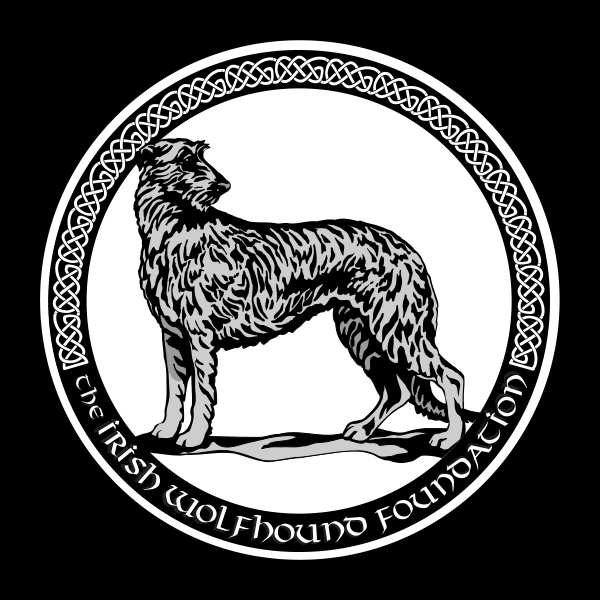[ENROLLMENT CLOSED] Bleeding Disorders in Irish Wolfhounds
The focus of this study is the hound that survives surgery, such as a spay, with no apparent problems and then, suddenly, in about 24 hours, starts to bleed heavily. This is often fatal since it is unexpected and the bleeding is difficult to control. This phenomena, which is fairly common in greyhounds, has been studied and, in that breed, and also in deerhounds, appears to be sometimes be related to a condition known as hyperfibrinolysis. The problem does not show up in traditional clotting tests because clots form perfectly well. Unfortunately, before true healing can take place, the clots dissolve prematurely, a process known as fibrolysis. (1)
There are drugs that prevent this phenomena if given before surgery and prophylactic use of those drugs is often recommended for greyhounds undergoing elective surgery. Recently it has also been recommended for Scottish Deerhounds and Irish Wolfhounds (2). The preventative, aminocaproic acid, is safe and effective, however, there are other potential reasons for delayed bleeding and a study has not been done to determine if hyperfibrinolysis is a problem in our breed.
In early 2019 the Irish Wolfhound Foundation was contacted by Daniel J. Fletcher, PhD, DVM, DACVECC of Cornell University, a specialist in critical care and an Irish Wolfhound owner. He had become aware of concerns among Irish Wolfhound owners about post-operative bleeding problems, some of them fatal. He had questions about how common this was and whether the bleeding was indeed due to hyperfibrinolysis. Dr. Fletcher had worked on development of a test for hyperfibrinolysis using thromboelastography (TEG). He had also used this device for characterizing the response to various preventative drugs. The TEG assays have to be run on whole blood within 30 minutes of collection, but the device is small and transportable. (3, 4) In fact a novel point of care device (VCM-Vet) has become available that simplifies and standardizes TEG testing. (5)
After reviewing Dr. Fletcher’s published work the IWF agreed that the first step was to do a survey and get a better idea of the prevalence of the problem and then design a study.
A survey was designed by Dr. Fletcher with IWF input and distributed via email lists and Facebook. He got a total of 100 responses from IW owners. Here are the preliminary results.
1. 47 respondees reported having one or more Irish Wolfhounds that experienced unexplained bleeding, with a total of 51 affected dogs, and 53 reported not seeing unexplained bleeding.
2. Of the 51 dogs with unexplained bleeding, 29 were within 1 week of surgery.
3. Of the 51 dogs with unexplained bleeding, 23 died.
4. Of the 29 surgical bleeds, 19 were spay/neuter surgeries.
It is to be expected that there are some biases to this data because people who had not experienced the problem were less likely to participate in the survey. Also dogs that have minor symptoms may not have been noted as having “abnormal” bleeding. This would account for the seemingly high mortality rate.
Nevertheless, it is obvious that a problem exists. Whether or not it is hyperfibrinolysis as seen in greyhounds is another question. Based on the results of the survey a study was proposed by Dr. Fletcher and funded by the IWF.
Blood samples were collected from 27 Irish Wolfhounds, mostly at the Irish Wolfhound Association of New England show in summer of 2019 by Dr. Fletcher and Elizabeth Rozanski, DVM, DACVIM, DACVECC, Associate Professor, Tufts University School of Veterinary Medicine, and tested for TEG. Additional samples were taken from 27 control dogs of other breeds, age and sex matched at Cornell. In addition to the TEG testing that was done immediately upon collection, blood samples were tested for other factors that could influence clotting or dissolution of clots. Data collection was nearly complete when the pandemic shut down the majority of work at Cornell and Tufts. As a consequence analysis of the results is just getting underway again. It is hoped that a publication will be ready later this year or early next year. Dr. Fletcher had planned to talk at the 2020 IWCA National and has agreed to come in 2021.
Thanks to Dr. Fletcher and Dr. Rozanski for their work and to IWANE for the assistance in collecting samples.
References
1. Lara-García a, Couto CG, Iazbik MC, Brooks MB. Postoperative bleeding in retired racing greyhounds. J Vet Intern Med [Internet]. 2008;22(3):525–33. Available from: http://www.ncbi.nlm.nih.gov/pubmed/18466249
2. https://www.iwclubofamerica.org/post-operative-bleeding-followup
3. Fletcher DJ, Rozanski EA, Brainard BM, de Laforcade AM, Brooks MB. Assessment of the relationships among coagulopathy, hyperfibrinolysis, plasma lactate, and protein C in dogs with spontaneous hemoperitoneum. J Vet Emerg Crit Care. 2016;26(1).
4. Fletcher DJ, Blackstock KJ, Epstein K, Brainard BM. Evaluation of tranexamic acid and ϵ-aminocaproic acid concentrations required to inhibit fibrinolysis in plasma of dogs and humans. Am J Vet Res. 2014;75:731–8.
Additional Study Details
| Study Date(s): | 07-22-2019 |
|---|---|
| Study Status: | Ongoing |
| Enrollment Status: | CLOSED to new enrollment |
| Lead Researcher(s): | Daniel J. Fletcher, PhD, DVM, DACVECC |


